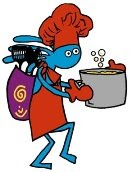Many cultures plan extravagant New Years Eve celebrations, but the ancient Babylonians were probably the first to do so. Four thousand years ago, they celebrated for eleven days beginning with the first crescent moon after the spring equinox. In a sense, January 1st is an odd date because there isn't anything special about it from an astronomical standpoint. Nor does the day conjure up themes of spring.
For a relatively young country, the citizens of the United States have come up with our own annual New Year’s Eve celebrations. Every year, nearly a million people crowd into Times Square for one of the world's largest annual parties. At 11:59 PM, a one-ton crystal ball will begin its one-minute descent down the 77-foot flagpole. At the stroke of midnight, party goers wearing funny hats will blow noisemakers and kiss their loved ones. Billions of people around the world will watch the televised event.
Check out the Top 10 New Year’s Traditions and Superstitions - we discovered this list at TopTenz, the ultimate top 10 list site.
10. Fireworks
9. Making Resolutions
8. Paying Off Your Debt
7. Kissing at Midnight
6. Singing “Auld Lang Syne”
5. First Footer
4. Nothing Should Leave the House
3. Lay Low & Do Nothing
2. Eat Luck Foods
1. What You Do On New Year’s, You Will Do All Year
(Source: http://www.toptenz.net/top-10-new-years-traditions-superstitions.php)
Foods to Avoid on New Year's
Be sure to avoid "unlucky" foods -- this is considered just as important as eating the good luck foods. If you were to serve something as unlucky as a chicken to your guests it could ruin their entire year. Many cultures believe that eating anything with wings is a no-no for New Year's because the bird could fly away, taking all of your luck with it. Chicken is thought to be especially unlucky because the bird scratches backwards (unlike the forward-thinking pig), which can possibly possibly lead to setbacks. The color white is a symbol of death in the Chinese culture, so avoid eggs, tofu, or white cheese. And, remember not to clean your plate too thoroughly — many cultures believe that leaving a little leftover food on your plate will usher in a year of plenty.
For those of you wanting to prepare and serve good luck food for your guests, Kokopelli's Kitchen chose the following recipe from “Arizona Territory Cook Book” by Daphne Overstreet. Permission to reprint granted by Golden West Publishers in Phoenix, AZ.
ROAST SUCKLING PIG
Clean piglet. Do not remove head or feet. Make a stuffing of dry bread, grated onion, sage, salt, pepper and warm water for moisture. Fill the cavity with stuffing and sew closed. Stand pig in pan of water, beef stock, onion, and butter and baste often. Bake slowly for three hours. Put a corn cob in his mouth and serve hot with baked apples.
For additional advice and guidance on cooking the whole hog, visit Ask the Meatman!
And if you can't find a whole pig to roast, visit McReynold's Farms. They are located in Phoenix, Arizona but their "farm-fresh roasting pigs" can be ordered online and shipped anywhere within the continental U.S., Alaska, and Hawaii. Their USDA farm fresh roasting pigs have been grain and milk fed to ensure the meat’s maximum flavor and tenderness. They are delivered raw and completely prepped and ready to cook (hair and insides removed).
skip to main |
skip to sidebar
Like us on Facebook!
Kokopelli's Kitchen Links
Search This Blog
Kokopelli's Kitchen
Followers
Blog Archive
-
►
2012
(12)
- December (1)
- November (1)
- October (1)
- August (2)
- June (2)
- May (1)
- April (1)
- March (1)
- February (1)
- January (1)
-
►
2011
(12)
- December (1)
- November (3)
- September (1)
- August (1)
- June (2)
- May (1)
- March (2)
- February (1)
-
▼
2010
(13)
- December (2)
- November (1)
- October (1)
- September (1)
- July (2)
- June (1)
- May (1)
- April (1)
- March (1)
- February (1)
- January (1)
